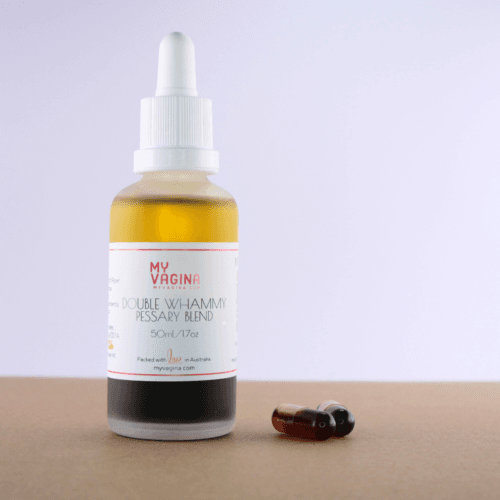The metabolic byproducts of Gardnerella species in the vagina depend on the type of nutrient they metabolise (e.g., glucose, glycogen, or amino acids).
These byproducts are central to understanding how Gardnerella contributes to bacterial vaginosis (BV), and how it impacts vaginal pH, inflammation, and symptoms.
Metabolism of glycogen/glucose by Gardnerella
Gardnerella species can metabolise glucose, which is often derived from glycogen. Glycogen is abundant in vaginal cells due to the impact of estrogen. Low estrogen means low glycogen, and vice versa.
This glycogen is broken down by enzymes produced by our bodies in the vaginal epithelium and typically occurs under low oxygen (anaerobic or microaerophilic) conditions.
Byproducts of glycogen/glucose metabolism by Gardnerella species
Acetic acid (a.k.a. vinegar)
A weak acid that contributes minimally to maintaining an acidic vaginal pH. It’s much less effective at lowering pH than lactic acid produced by lactobacilli.
Lactic acid
Gardnerella can produce some lactic acid, but the amount is minimal and insufficient to maintain a healthy vaginal pH when lactobacilli are depleted.
Ethanol and carbon dioxide (CO₂)
Minor byproducts of glucose fermentation are ethanol and carbon dioxide, both of which have little effect on the vaginal environment.
Overall impact of glycogen/glucose metabolism in the vagina
Glycogen/glucose metabolism by Gardnerella contributes some acidity but is not sufficient to maintain the optimal vaginal pH of 3.8–4.5, leading to an environment where other anaerobes can thrive.
Metabolism of amino acids by Gardnerella
During limited glycogen or glucose (e.g., during dysbiosis or low estrogen states like breastfeeding or postmenopause), Gardnerella shifts to metabolising amino acids, derived from the breakdown of proteins.
Amino acid metabolism increases vaginal alkalinity (pH > 4.5), which disrupts the protective barrier provided by lactobacilli and promotes further dysbiosis.
Byproducts like biogenic amines and hydrogen sulfide worsen symptoms of BV, including malodour and irritation.
Byproducts of amino acid metabolism by Gardnerella species
Ammonia
Produced through the deamination of amino acids, ammonia is strongly alkaline, raising vaginal pH and creating a less hospitable environment for protective lactobacilli.
Putrescine and cadaverine (fishy and ‘rotten meat’ smell)
Biogenic amines are produced from the breakdown of the amino acids lysine (produces putrescine) and ornithine (produces cadaverine). As you might guess from these names, these amines are also the result of rotting organic material, such as meat.
Putrescine and cadaverine are responsible for the characteristic fishy odour associated with BV, especially when they volatilise in alkaline pH.
Hydrogen sulfide
Hydrogen sulfide is produced from the metabolism of sulfur-containing amino acids (e.g., cysteine, methionine) and can contribute to inflammation, tissue irritation, and unpleasant odours.
Short-Chain Fatty Acids (SCFAs):
Acetate, propionate, and butyrate are common byproducts of amino acid metabolism by Gardnerella species. While these SCFAs can provide energy to some commensal bacteria, their production often accompanies dysbiosis and inflammation in the vaginal environment.
Biofilm formation
Gardnerella species produce metabolic byproducts that contribute to the formation of a biofilm, a structured bacterial community that adheres to the vaginal epithelium.
Biofilm formation stabilises Gardnerella dominance, perpetuates dysbiosis, and makes it harder to restore a lactobacilli-dominant microbiome.
Byproducts that support biofilm formation
Extracellular polysaccharides
Components of the biofilm that protect Gardnerella and associated anaerobic bacteria from immune responses and antibiotic treatments are extracellular polysaccharides.
Sialidase and other enzymes
Gardnerella produces sialidases, which degrade mucous and host epithelial cells, releasing more proteins and glycans for bacterial metabolism.
This enzymatic activity also contributes to inflammation and epithelial damage.
Metabolism of lactic acid
Under some conditions, Gardnerella can metabolise lactic acid (produced by lactobacilli or itself in small amounts).
The utilisation of lactic acid by Gardnerella reduces the acidity of the vaginal environment, further favouring its growth and that of other anaerobic bacteria.
Byproducts of lactic acid metabolism by Gardnerella species
Acetate and propionate
Acetate and propionate are less acidic than lactic acid and contribute to a gradual increase in pH.
Carbon dioxide (CO₂)
Fermentation releases CO₂.
Summary of Gardnerella’s metabolic byproducts
| Nutrient | Metabolic Byproducts | Effect on Vaginal Environment |
|---|---|---|
| Glucose/glycogen | Acetic acid, lactic acid (small amounts), CO₂ | A gradual rise in pH, further reducing lactobacilli viability. |
| Amino acids | Ammonia, putrescine, cadaverine, H₂S, SCFAs | Mildly acidic but insufficient to maintain a healthy pH. |
| Lactic acid | Acetate, propionate, CO₂ | Gradual rise in pH, further reducing lactobacilli viability. |
| Biofilm-related | Extracellular polysaccharides, sialidases | Alkaline pH, characteristic BV odour, and increased dysbiosis risk. |
Clinical implications
The ability of Gardnerella species to shift their metabolic strategies and produce different byproducts underlies their role in bacterial vaginosis.
Gardnerella’s metabolism disrupts the vaginal microbiome by raising vaginal pH and facilitating the growth of other anaerobic bacteria and reducing lactobacilli dominance. Biogenic amines and volatile sulfur compounds produce odours, the characteristic malodour of BV. Byproducts like hydrogen sulfide and sialidase enzymes contribute to tissue damage and inflammation.
Effective treatment strategies for Gardnerella-related dysbiosis often focus on restoring lactobacilli dominance, lowering pH, and disrupting biofilms, such as My Vagina’s range of non-antibiotic treatments.
However, sometimes addressing the abundance of energy sources and byproducts available in the vagina can produce even better results for chronic/recurrent BV. Book with a My Vagina vulvovaginal specialist clinical naturopath for advice.
References1,2
- 1.Anton L, Ferguson B, Friedman ES, Gerson KD, Brown AG, Elovitz MA. Gardnerella vaginalis alters cervicovaginal epithelial cell function through microbe-specific immune responses. Microbiome. Published online August 4, 2022. doi:10.1186/s40168-022-01317-9
- 2.Meng L, Meng M, Zhang R, et al. Microbiome-producing SCFAs are associated with preterm birth via trophoblast function modulation. Han Y, ed. mBio. Published online November 11, 2024. doi:10.1128/mbio.02702-24

Get a fresh perspective with a qualified, experienced vulvovaginal specialist naturopath.
This product has multiple variants. The options may be chosen on the product page
The most comprehensive vaginal microbiome test you can take at home, brought to you by world-leading vaginal microbiome scientists at Juno Bio.
Easy-to-use BV and AV treatment program.

Promote and support a protective vaginal microbiome with tailored probiotic species.







